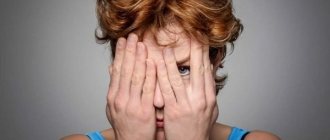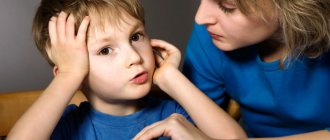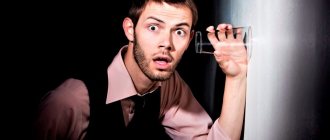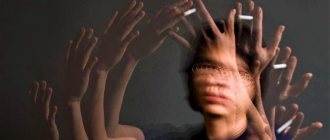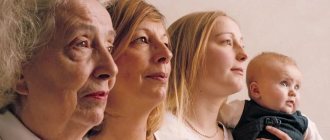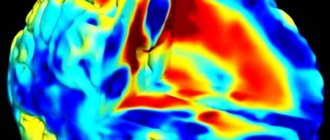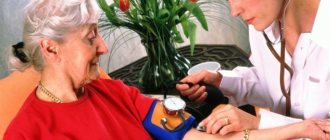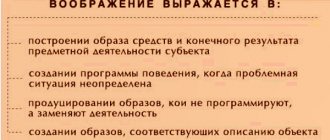According to the generally accepted definition, schizophrenia is a mental disorder in which a person loses the ability to distinguish between what is imagined and what is real. In many cases, people who show signs of schizophrenia behave quite strangely, and their behavior in some cases may even seem shocking. If a person experiences a sudden change in behavior and personality due to a loss of contact with reality, doctors talk about the manifestation of a psychotic episode.
Symptoms of schizophrenia may worsen and become less noticeable during relapses of the disease and during remission.
The term “schizophrenia” refers to a whole complex of relatively diverse mental disorders. However, with different types of schizophrenia, people often exhibit similar symptoms.
Main signs of schizophrenia
The diagnosis is made based on the international classification of diseases (ICD-10). Schizophrenia is presented in section F20. Main criteria:
- Openness of thoughts - someone puts them in or takes them away, others know what a person is thinking about.
- Ideas of influence - a person is sure that someone controls his thoughts, actions, body movements, he is in the power of secret services, aliens or sorcerers.
- “Voices” in the head or body that comment and discuss a person’s behavior.
- Other ridiculous ideas include being able to control the weather or communicate with otherworldly forces, or being related to famous political or religious figures. The content of these ideas may vary depending on a person's beliefs and events in society.
Etiology and pathogenesis
According to modern concepts, schizophrenia belongs to a group of diseases with a hereditary predisposition. There is a significant accumulation of schizophrenic psychoses and personality anomalies in families of patients with schizophrenia, as well as high concordance in identical twin pairs. However, to date, the type of inheritance remains unclear. At the same time, an undoubted role in the manifestation of the disease is played by the influence of the external environment, as well as general biological changes in connection with somatic diseases and endocrine-age factors.
The specific pathogenetic mechanisms of the disease cannot be considered established, but most modern researchers believe that the cause of psychoses is disorders of neurotransmitter metabolism.
In addition to biological hypotheses and theories, various theories of the psycho- and sociogenesis of schizophrenia are still widespread in the West. These include the psychoanalysis of S. Freud and the psychodynamic concept of A. Meyer, who consider schizophrenia as a special development of personality as a result of early (childhood) interpersonal conflict, mainly sexual. This group also includes modern vulgar sociological concepts of schizophrenia as a consequence of family or social conflict. Philosophical-phenomenological, “anthropological” theories of schizophrenia as a special type of existence (existential model) have become less widespread. All these ultimately idealistic concepts are, from a scientific point of view, unproven and unproductive, and the medical practice they engendered turned out to be untenable.
Features of the disease
Schizophrenia refers to chronic diseases that destroy the human psyche. It can occur continuously, or it can manifest itself in attacks, which become more and more pronounced each time. If the disease does not cause obvious signs in the patient, then the person may simply become very dry, he will lose interests, he will stop experiencing emotions and showing any desires. According to the ICD, schizophrenia is coded F20.
The disease is classified according to its manifestations, and the types of schizophrenia in adults and children are partially different. This is due to the fact that certain symptoms are characteristic only of a particular age.
In adults, schizophrenia has the following types:
- Simple - there are practically no external manifestations of the disease, there are no hallucinations, the person behaves naturally, but gradually becomes unemotional, dry in relationships and withdrawn.
- Paranoid (paranoid) - the patient is sure that another person or group of people is reading his thoughts, provoking illnesses and persecuting him, and in some cases he feels fake superpowers.
- Catatonic - a person is distinguished by repetitive movements, he can sway in different directions, walk in circles, continuously wave his arms, repeat the same words over and over again.
- Hebephrenic - the patient’s behavior resembles a child, he often teases others, jokes inappropriately, jumps and makes faces, while he is not aware of the asocial nature of his behavior.
A sluggish form of schizophrenia is also distinguished separately. It is characterized by very slow development, and only the rate of formation of irreversible mental damage is assessed, and the severity and speed of manifestation of symptoms have no significance. Most often it is combined with loss of emotionality and interests, antisocial behavior, as well as impaired speech and intellectual functions.
In most cases, children are diagnosed with a sluggish form of the disease. There have also been many cases of malignant schizophrenia, which has an extremely negative impact on the overall development of the baby. Other types are found much less frequently, which is due to the characteristics of the child’s psyche. A small child or teenager prone to schizophrenia will begin to feel a worsening of the condition over time, and the disease may develop into a new form.
Types and types of symptoms of schizophrenia
- continuous-progradient - the disease flows continuously with a gradually increasing personality defect;
- paroxysmal-progradient - an exacerbation of the disease replaces a period of clinical remission, the destruction of personality increases with the progression of the disease;
- recurrent - attacks of schizophrenia are replaced by states of stable rest, personality changes are insignificantly expressed; A favorable type of disease course in which a person maintains working capacity and social interests for a long time.
Productive and negative core symptoms of schizophrenia
Productive symptoms in schizophrenia include delusions, false perceptions, and strange behavior. Delusional thoughts are most often associated with feelings of special destiny, persecution, jealousy, or fantastic cosmogonies. Pseudohallucinations are usually of a verbal nature, commenting on or criticizing the patient’s actions. Other deceptions of perception can be in the form of oneiric visual hallucinations (cosmic dreams), changes in taste, crawling of non-existent insects or worms and a distorted perception of one's body.
Negative symptoms are expressed as apato-abulic syndrome, i.e. a decrease in the emotional-volitional manifestation of a person. Sooner or later, this leads to a personality defect in schizophrenia - such changes in the patient’s psyche that make it impossible for a person to fulfill his family and social functions. Patients with schizophrenia with a severe personality defect are incapable of productive activity. They give up studying, cannot hold down a job, stop caring about their loved ones and taking care of their appearance.
Why do they strive to do without antipsychotics?
History will tell us how schizophrenia will progress without antipsychotics. Before their appearance in the early 50s of the 20th century, patients were tied to beds, kept in rooms with bars on the windows and treated worse than criminals, even if the unfortunate people had not done anything criminal. Treatment was often lifelong or incredibly long. Modern patients who have tried to take some alternative path, if they are actually sick, and not someone who once rejected the army through the discovery of a diagnosis, talk about several months of great suffering.
People go this route for several reasons:
- they are afraid of psychiatry as such - killer doctors, sadistic orderlies, loss of rights;
- they are afraid of the side effects of antipsychotics - squashing and sausage, mental capacity decreases;
- they fear that sooner or later antipsychotics for schizophrenia will provoke a new psychosis - there is an opinion that after 5-7 years of taking antipsychotics they begin to act differently and become the cause of more severe forms of schizophrenia.
As a result, an antipsychiatric movement, quite popular in certain circles, is formed. It is based on the concept that completely healthy people are supposedly kept in psychiatric hospitals. The methods are terrible and everything is gloomy. Scientologists are almost the most evil of all. At the same time, critics rarely offer any alternative ways. We are already familiar with the example of those who offer. These are the authors of the cytokine treatment method. The approach itself excludes the use of traditional, typical and atypical, drugs of all types during the course, but this is simply another drug therapy.
The same can be said about the method of Stanislav Grof. He uses psychedelics during treatment - drugs that can put a person into an altered state of consciousness. However, it must be taken into account that Grof has long denied the use of LSD as such, in isolation from psychotherapy. The shock that LSD creates does not lead to anything good. At Grof's clinic, patients are taught how to relate to the unfolding psychological theater. This is complex, painstaking work that simply cannot be put into production. Doctors and patients need to be trained, and the patients themselves must have a certain level of intellectual development. Otherwise, the psychedelic drug will simply immerse the patient in the world of psychic theater. In 80% of cases there will be a negative result if you leave it there to the mercy of fate.
Worth seeing: Nursing process in schizophrenia
Signs of various forms of schizophrenia
Depending on the form of the disease, manifestations may vary. With residual, mild positive symptoms are observed. Manic is characterized by:
- pronounced delusions of persecution, obsessive ideas, profuse verbose speech;
- a person is able to talk about any objects, actions, environmental phenomena for hours without stopping;
- Now this type is called manic-depressive psychosis.
Alcoholic schizophrenia is not classified as a separate form. This name was invented by people who are not professional psychiatrists. In medicine, a condition caused by long-term abuse of alcoholic beverages is called alcoholic psychosis.
Treatment
Therapy for this disease depends on a number of factors, and therefore a specific course of treatment should be developed exclusively by a specialist. The basis of modern treatment for schizophrenia is medication and psychotherapy. The main goal of such treatment is to achieve long-term remission.
If treatment for schizophrenia was carried out in a timely and competent manner, then the probability of subsequent relapses of the disease is only 25%. Thus, we can talk about lifelong remission of the disease, which will allow the patient to return to normal life.
Drug treatment
Treatment of schizophrenia is based on medication. The course of therapy is developed individually, based on the following factors:
- type of disease;
- degree of progression of pathology;
- features of the course of schizophrenia;
- individual characteristics of the body;
- symptoms.
The course of therapy is based on taking antipsychotic or neuroleptic drugs. There are two generations of these drugs. The first remedies were invented in the mid-50s of the last century. These are typical antipsychotics, the effectiveness of which is based on blocking the production of dopamine.
A new generation of psychotic drugs was released 30 years later. They are called atypical antipsychotics, which have a direct effect on the brain centers that produce serotonin.
Regarding the effect on the psyche, typical antipsychotics are divided into strong and weak. The action of the former is based on the break of psychosis, which is why they are able to quickly suppress the symptoms of schizophrenia. Therefore, they are often prescribed to patients during an exacerbation of the disease.
Typical antipsychotics have a serious drawback, which is reflected in the presence of numerous side effects
Therefore, these medications should be taken with caution. To reduce possible negative effects, strong antipsychotics are taken together with corrective drugs such as Cyclodol.
Typical antipsychotics include the following drugs:
- Moditen;
- Haloperidol;
- Trifluoperazine;
- Majeptyl.
Taken at any time, regardless of meals
Drugs in this group have predominantly sedative properties. They are not able to completely eliminate the manifestations of severe psychosis, therefore they are taken during remission or in sluggish forms of the disease. Weak antipsychotics are also prescribed to children who do not have severe forms of psychosis.
It is possible to obtain a pronounced effect from taking typical antipsychotics in half of the patients. Approximately a quarter of patients experience slight improvement in their condition, and 10% of patients have no treatment results.
Atypical antipsychotics are considered more universal drugs, which can effectively combat the productive and negative symptoms of the disease, while having a milder effect on the patient’s psyche. As a result, the list of side effects for these drugs will be much shorter.
The most popular drugs in this group are:
- Leponex;
- Olanzapine;
- Risperpet.
Such drugs can suppress the following signs of mental disorders:
- illusions and hallucinations;
- rave;
- apathy and lack of will;
- decreased mental function, etc.
As a rule, the specialist prescribes the patient to take one drug. In rare cases, it is possible to use two drugs simultaneously. The dosage and course of treatment are determined by the doctor.
When treating any form of schizophrenia, the dose of the drug is increased gradually over several weeks.
Psychotherapy
Hypnosis sessions are good for coping with pathology
Treatment for schizophrenia does not end with taking medications. Patients with such mental disorders really need psychological support provided by relatives and specialists.
Modern psychotherapists prescribe the following procedures to their patients:
- personal conversations;
- hypnotic influence;
- cognitive behavioral therapy.
The main task of the specialist is to show the patient the fine line between real life and fiction.
Communication is of great importance in the treatment of illness. Many schizophrenics are withdrawn and do not make contact even with relatives, not to mention strangers. For such a person’s life to return to normal, he needs help. And the best therapy option in this case would be to attend groups to communicate with similarly sick people, which will allow the patient not to feel like an outcast and talk about his problems with others.
Optional symptoms
These symptoms are additional, meaning they are less specific to schizophrenia and may occur in other diseases. These are productive symptoms (delusions, hallucinations). However, some of them are considered more or less typical of schizophrenia. Due to the fact that it is easier to identify productive symptoms than negative ones, today productive symptoms (rank I symptoms) are used as the main diagnostic criteria for schizophrenia. These include:
- taking away thoughts, putting in thoughts, sounding thoughts;
- hallucinatory voices projected inside the body or beyond the sensory reach of the commentary content, or from a third person;
- delusions of influence;
- ridiculous crazy ideas (communication with aliens, weather control).
To make a diagnosis, the presence of one of the four listed symptoms for at least 30 days is sufficient.
The remaining productive symptoms (other types of hallucinations, persecutory delusions, catatonia, depression, mania) are of auxiliary value for diagnosis.
Diagnosis of schizophrenia
The diagnosis of schizophrenia is made based on several core symptoms of the disease. These include:
- autism (isolation, isolation from the world);
- inappropriate, ridiculous, often aggressive behavior in a group of people;
- thinking disorder (a person can speak in a bunch of words, or put forward statements that do not correspond to reality and defy logic - delusional ideas);
- emotional dullness (inability to experience emotions, coldness, indifference to people, lack of higher emotions);
- in some cases, perception disorders are possible: visual and auditory hallucinations inside the head (pseudohallucinations).
After suffering the first attack or exacerbation of an existing disease, there is an increase in the symptoms of “deficit” - the extinction of emotions and volitional activity (the ability to do something). The patient is completely immersed in his own world, and gradually loses touch with reality, sometimes he can be unmotivatedly aggressive, in accordance with his inner experiences.
How does schizophrenia progress?
This disease has many different shades of manifestation and course. In some patients, this disease may manifest itself in the form of mild neurotic symptoms. Such conditions are often classified as borderline mental disorders according to ICD-10. At the same time, this is absolutely true. At this stage of development, it can be stopped in its development. But this requires initially correct diagnosis and correctly chosen treatment tactics.
In more severe cases, this disease can manifest itself in disguise. Most often, relatives or close people begin to pay attention to the formation of schizophrenia only with some illogical statements of theories, sudden inappropriate behavioral actions, or during suicide attempts. Sometimes a person may freeze in certain positions for a while. But, unfortunately, at this moment the phase of the disease enters the acute period. When urgent assistance from a psychiatrist and hospitalization are already necessary.
Sometimes the patient’s internal experiences instill horror in them, giving rise to a feeling of fear and anxiety. They often withdraw into themselves. People with schizophrenia may talk nonsense and sit motionless and silent for a long time. From the outside they may seem absolutely normal, until they start talking about what they really think.
Most sick people have difficulty concentrating, it is difficult for them to work, maintain hygiene, and communicate with other people. Some people with schizophrenia, on the contrary, may exhibit increased activity. This can occur in phases of increased activity and phases of decreased energy and mood.
How do you know if a person has schizophrenia?
In fact, the symptoms of schizophrenia are very diverse and vary from person to person. In some cases, it can be confused with the characterological characteristics of a person or some situational characteristics of the reaction of the nervous system.
There is no clear gradation, with the exception of acute manifestations of the disease. In addition, latent schizophrenia can last for years or decades. And only a full examination by a competent psychiatrist can reveal pathology.
We can often see hidden forms of schizophrenia in those around us, but accept this as a character trait. Therefore, it is not worth making hasty conclusions about a person and diagnosing him. Remember that only a competent doctor can diagnose schizophrenia. At the same time, it should be noted that this diagnosis must be confirmed only by a commission examination. Only a council of three or more psychiatrists can confirm this disease.
Stages of treatment for schizophrenia
Conventionally, the entire cycle of treatment measures can be divided into three separate stages.
- The first stage - relief therapy - involves taking measures to eliminate the symptoms of psychosis. The goal of treatment is to completely eliminate the productive symptoms of the disease, achieving the absence of hallucinations, delusional ideas, and psychomotor agitation.
- The second stage – stabilizing therapy – is aimed at consolidating and maintaining the effects achieved in the previous period.
- The third stage - maintenance therapy - is focused on maintaining a stable mental state of the person, preventing the return of symptoms of the disorder, and prolonging the period of remission.
To achieve success in medical treatment, it is necessary to begin treatment as early as possible. Consultation with a psychiatrist is an advisable step when prodromal signs appear or at the first changes in a person’s mental life. It should be borne in mind that stopping an attack that has reached its maximum is a very difficult task. Acute psychotic conditions cause rapid changes in the personality structure, depriving the patient of the opportunity to lead a normal life, engage in everyday activities, and perform professional duties.
The duration of full-fledged treatment measures from the moment of relief of the first or next episode of psychosis is at least 12 months. The relief therapy stage lasts on average from 2 to 3 months. The average duration of stabilizing therapy is 6 months. The period of maintenance and preventive treatment should be at least 12 months.
Causes of schizophrenia
Modern science has not fully studied all the causes of schizophrenia. Often this mental disorder is caused by prolonged stress, overwork, or psychological trauma. There is also a genetic predisposition. However, there are cases when schizophrenia appears for no apparent reason in a previously mentally stable person. Scientists put forward several theories about the occurrence of this disease, which consider reasons such as:
- Excessive production of dopamine, which affects the functioning of the nervous system
- Too productive activity of serotonin receptors
- Brain abnormalities due to infections or genetic components
- Split personality, one of which dominates external circumstances
- Effect of toxic substances
- Oxygen starvation of the brain
Regardless of the causes of schizophrenia, psychosocial factors play an important role in its manifestations and subsequent treatment.
Modern treatment of schizophrenia during an attack
When a person begins an attack of schizophrenia (psychosis), you need to see a doctor as soon as possible, who will begin the necessary relief treatment. Currently, various drugs from the group of neuroleptics (antipsychotics) are primarily used to relieve psychosis.
The most effective first-line drugs for the relief treatment of schizophrenic psychosis are atypical antipsychotics, since they are able to eliminate productive symptoms (delusions and hallucinations) and, at the same time, minimize disturbances in speech, thinking, emotions, memory, will, facial expressions and behavior patterns. That is, drugs in this group can not only stop the productive symptoms of schizophrenia, but also eliminate the negative symptoms of the disease, which is very important for the rehabilitation of a person and maintaining him in a state of remission. In addition, atypical antipsychotics are effective in cases where a person cannot tolerate other antipsychotics or is resistant to their effects.
Features of treatment for men and women
When choosing a treatment method, medication and its dosage, the doctor takes into account not only the form of the disorder, the manifestations of the symptoms of the disease, but also gender. This is due to the peculiarity of perception of the effect of the drug. To eliminate productive symptoms in women, the same drugs are used as for men, but in higher dosages. The dosage is selected individually; in some cases, a small, fragile woman requires a higher dose than a large, tall man.
Modern methods of therapy for schizophrenia
Every year, science offers new and more effective methods of treating schizophrenia. Currently, if it is possible to use these achievements, the carrier of the disorder can lead a normal life, engage in professional activities, and have a family. Treatment methods for the disorder are usually divided into 2 groups:
- psychosocial therapy;
- biological methods.
The general scheme of such treatment contains the following methods:
- drug therapy;
- psychotherapy aimed at correcting the patient’s behavior;
- career guidance taking into account health status;
- working with relatives of the carrier of the disorder.
Treatment of schizophrenia
When making a diagnosis, it is necessary to collect a complete history of the patient’s life and analyze what causes contributed to the symptoms. A complete examination of the patient is carried out, where it is important to pay attention to the presence of positive or negative symptoms.
Basic diagnostic measures: MRI of the brain, in order to exclude malignant neoplasms and changes in the structure of the meninges; EEG, to record the bioelectrical activity of the brain; general blood and urine analysis; psychological tests; studies of the functions of the cardiovascular, digestive and endocrine systems in order to identify concomitant pathologies.
Treatment of schizophrenia is carried out under the strict guidance of a psychiatrist. Much attention is paid to adjusting the patient’s psychological state: working with a psychologist, talking about the current condition and what the patient himself associates with the occurrence of the disease. As a drug treatment, preference is given to neuroleptics: they effectively relieve psychotic attacks and slow down the progression of the disease.
Also, sedatives and vitamin complexes are prescribed to improve the general condition of the body and calm the patient. If there are pathologies from the endocrine, respiratory and other systems, appropriate symptomatic therapy is selected.
The duration of treatment depends on the form of schizophrenia and the prognosis: relief of symptoms can take up to two months, and stabilization of the condition can last up to six months.
Basic therapy
The main ways to best get rid of schizophrenia include medication and psychotherapeutic treatment. They are most effective and can be used for people of any age. But treatment should begin only after receiving a doctor’s prescription.
Drug treatment
Taking special medications is a prerequisite for eliminating symptoms. When the patient begins to take medications, he will gradually overcome one symptom after another. After some time, all manifestations of schizophrenia will disappear, and the person will feel good.
Drugs and dosage are always selected individually. They may change during therapy, because It is very important to choose the most effective remedy. It should be borne in mind that the first effect will become noticeable only a few weeks after starting to take the medication.
The prescribed drugs have 3 goals: to relieve symptoms, stabilize brain function, and maintain the patient’s health. Several categories of drugs can be used for this:
- Neuroleptics (Aripiprazole, Olanzapine). They are the basis of treatment and help get rid of delusions, hallucinations, closed personality, and also restore the patient’s mental state. Antipsychotics are administered intravenously or taken in tablet form.
- Tranquilizers and sedatives (Lexotan, Propazine). They calm the patient, help overcome anxiety and fear, relieve persecution mania, and reduce physical arousal. Relatives should control the use of such funds, because a schizophrenic may take too large a dose, which is extremely dangerous.
- Antidepressants (Venlafaxine). The use of such remedies allows one to cope with negative symptoms, relieving the patient of apathy and returning him interest in the world around him. As with sedatives, medications should be monitored to avoid overdose.
Doctors can prescribe other effective remedies, selecting them individually. Additionally, many patients are prescribed modern medications aimed at improving brain function to avoid impairment of cognitive skills, as well as vitamin complexes to maintain general health.
Psychotherapy
The second important component of treatment is psychotherapy. It should be used at any stage of the disease, because The doctor helps you overcome the symptoms and fight schizophrenia on your own. Several psychotherapeutic methods are used, and some of them are aimed at the entire family of the patient. What exactly does the doctor prescribe:
- Behavioral psychotherapy. The goal of the specialist’s work is to bring the patient to awareness and acceptance of his problem, as well as help in regulating the disease and controlling his condition.
- Cognitive activities. Special training of cognitive functions allows you to avoid the loss of many skills and knowledge, as well as restore lost ones. This therapy is especially effective for adolescents.
- Psychoeducation. This technique involves conducting group sessions in which patients must make sure that others have the same problem. Their goal is to alleviate the patient’s condition and restore his psyche.
- Family psychotherapy. The doctor works with all family members at once, explaining the peculiarities of interaction with the patient, while the specialist helps them accept the state of the schizophrenic and learn to bear responsibility.
- Occupational therapy. Gradually, the specialist teaches the patient to perform this or that work, which helps develop his social skills and increase his ability to work. After a few sessions, patients become more independent and will require much less assistance with daily tasks.
If a child suffers from schizophrenia, parents must not only take a responsible approach to the treatment procedure, but also support the patient throughout all stages of therapy. Therefore, family psychotherapy classes are especially important for them.
Non-drug treatments for schizophrenia
Sometimes good results in the treatment of schizophrenia are observed when using such classical techniques as insulin shock and even electroconvulsive therapy.
Insulin shock treatment is carried out by administering insulin dissolved in saline through a dropper until the onset of coma. Then glucose is administered and the patient regains consciousness. Prescribed to patients with acute psychosis, somatically weakened, especially when drug treatment is ineffective.
Electroconvulsive therapy - using a special device, is carried out for patients resistant to drug therapy and with chronic depression.
Psychotherapy as a method of treatment
Types of psychotherapy
Treatment with psychotherapy for schizophrenia requires quite a lot of time - this must be taken into account by patients and their families. Before going to the first session, you should be absolutely sure that the patient’s general mental state allows him to accept such therapy, otherwise the doctor simply will not be able to reach the patient.
There are two main types of psychotherapy – individual and group. Each has a number of features.
Individual psychotherapy
Individual sessions are the beginning of psychotherapeutic treatment. The fact is that at first it is difficult for the patient to get in touch with the doctor, not to mention attending group sessions.
Group sessions
Group psychotherapy requires preparation. The patient is admitted to it only after a detailed study of existing problems in individual sessions. In general, group psychotherapy is the last preparatory stage before the patient returns to society, and therefore is very important.
Hypnosis
Hypnotherapy is the most controversial treatment for schizophrenia. In some cases, hypnosis can even be dangerous, as it affects the unconscious of a person with an unstable psyche and unpredictable reactions.
Complementary therapy
It is recommended not to limit yourself to medications and psychotherapy and to use additional methods, as well as to treat schizophrenia with folk remedies. They can only be used after consultation with your doctor, because... there is a possibility of developing side effects.
Unusual methods
It is allowed to use other methods of treatment that are not so widely used. They complement the main therapy, enhancing the effect against the disease. Can be used:
- ECT. Electroconvulsive therapy is used in cases where the patient has movement disorders (frequent, repetitive movements that he cannot control).
- Insulin comatose therapy. Prescribed when there is no effect from the main treatment. This therapy involves injecting a small amount of diluted insulin into the blood through a needle. First, the patient falls into a coma, and then returns to a conscious state when he is additionally injected with glucose. This has a positive effect on the mental state of the patient.
- Hypnosis. Conducting several hypnotic sessions helps the patient overcome the symptoms of schizophrenia, because... the openness of his consciousness during the procedure allows him to instill any information.
In some cases, the use of such treatments can cause dangerous consequences. Therefore, they are highly not recommended for small children.
Folk remedies
Traditional medicine recipes can perfectly complement drug therapy. They help get rid of many manifestations of the disease, as well as restore the patient’s condition. The two most effective folk remedies are:
- Medicinal comfrey. The herb should be crushed (1 tsp), add water (1 l), boil for 10 minutes, and then let it brew for about one hour. You need to drink one liter of the decoction every day, dividing this volume into small portions. The course of treatment is 2 weeks. The product is excellent against positive symptoms.
- Digitalis. You need to pour boiling water (300 ml) over the plant (1 tsp) and leave for 12 hours. After infusion, take half a glass every 4 hours. The drink effectively eliminates most symptoms.
You can also use a herbal mixture of lemon balm, thyme and valerian. They have a calming effect and relieve many manifestations of schizophrenia.
Additional therapy cannot replace primary therapy. Therefore, you should pay attention to it only in extreme cases, after consulting your doctor in advance.
Rehabilitation
A rehabilitation complex of measures is carried out at all stages of treatment for patients with schizophrenia. This complex includes the maximum possible limitation of measures of constraint for patients - for example, their stay in a closed department or observation ward, as well as the active inclusion, as acute manifestations of the disease are relieved, of occupational therapy, cultural therapy, group therapy, etc. It is necessary to widely use therapeutic leave with the possibility spend the end of the week at home or transfer patients to a semi-hospital hospital (day hospital).
The employment of patients with the necessary reorientation of goals and attitudes is of great importance, especially when their ability to work decreases. Employment must be adequate to the condition of the patients. In the chronic course of the disease with residual and psychopathological symptoms and personality defects, it is necessary to attempt labor and social adaptation of patients in special conditions, where daily psychiatric observation is provided - in medical workshops, special workshops at industrial enterprises, etc.
Related posts:
- Anonymity in psychiatry Psychiatry is a branch of medicine whose activities are aimed at studying the causes...
- Treatment of panic attacks: what is included in the course of treatment? Panic attack (PA) is an attack that develops in the shortest possible time...
- Features of the course of schizophrenia in older people Schizophrenia is a mysterious, terrible disease. In the minds of the general public...
- Causes of Depression in Children Depression is a mental illness marked by persistent feelings of sadness, irritability, loss...
How to get rid of schizophrenia at home
If you think that this article is meaningless, since such a “terrible” disease as schizophrenia can only be cured in the conditions or with the vigilant help of appropriate psychiatric institutions, you are deeply mistaken.
The disease, the cure for which we will talk about, has been observed in the history of mankind from its earliest times, when what is now commonly called “traditional medicine” did not exist at all. No one used such powerful and in many ways dangerous psychotropic medications as today, and, however, patients were not left without adequate and successful treatment. Let's start with the fact that, yes, if we are talking about an advanced and severe form of schizophrenia, when the patient is capable of harming both himself and others, then his condition should be monitored by a specialist. In other cases, if there is no desire to “sit down” on strong medications, which, for the most part, cause addiction to their use, you can and should try to fight the scourge at home. Moreover, if you believe the same doctors who claim that manifestations of mild/moderate schizophrenia (in its many different forms) are observed in half of the generally healthy population of the Earth. But let's define the most common signs of this disease. Symptoms of schizophrenia:
- persistent feeling of anxiety;
- thinking falls outside the scope of the “standard”, beliefs and ideas acquire a somewhat exotic connotation, reasoning is devoid of logic that others understand, speech is confused;
- the person becomes extremely absent-minded, the perception of reality is disrupted, hallucinations appear;
- apathy, depression, weakening of physical and mental activity;
- inadequate expression of emotions or their complete absence;
- isolation, unsociability or, conversely, aggressiveness towards others is possible, there is a clouding of the personality;
- disturbances in coordination, movements or facial expressions, etc.
How to get rid of schizophrenia at home?
Treatment of mental illness is a whole range of measures; if you want to get rid of it as quickly as possible, you need to combine conventional therapy (described below) and drug treatment. The most effective, according to close patients suffering from schizophrenia, was the drug available at this link. It has a calming effect, relieves depression and prevents obsessive thoughts from developing. A revolutionary decision, and most importantly, the right one. We recommend.
They say that it will not be possible to do this completely: it can only be greatly reduced in size and driven into the very extreme corner of the subconscious, constantly being on the alert and guarding one’s mental peace from it. But such a result is only possible if the approach to treatment is taken seriously and the unconditional and comprehensive support of loved ones who are able to be there at the slightest threat of failure. Here are the most optimal conditions to achieve maximum effect:
- the living space should be constantly ventilated, it is better to sleep with the window slightly open (at least a millimeter) at any time of the year;
- take daily walks in the fresh air, walking barefoot in warm weather; in hot weather, it is mandatory to wear a hat;
- limiting as much as possible the possibility of events and circumstances having a negative connotation. This also applies to films/music/literature that can evoke negative emotions;
- correct diet: complete abstinence from alcohol (and from cigarettes/drugs, including), partial/complete - from coffee and strong tea (can be green or from herbs / fruits), it is advisable to give up meat altogether - vegetarianism is fraught with psychological and physiological ease and is rightfully considered the most correct perception of the phrase “healthy eating”;
- clothes should also not carry negative energy, so avoid synthetic fabrics, giving preference to cotton and linen;
- Full physical activity is a must. A morning half-hour jog can help get rid of fears and hallucinations, as well as various sets of gymnastic exercises along with dousing with cold water (or at least wiping and taking a contrast shower);
- the patient needs to establish a daily routine and try to stick to it. For example, an excellent option would be the following: 5-7 am - wake up; charger; breakfast; affairs; 12-14 — lunch; "affairs"; 17-18 - dinner; "affairs"; 21-22:30 - shower; 23:00 maximum - sleep. At first it will be difficult to get used to and follow, but with daily diligence, the daily routine will become an integral part of your health and life in general.
Folk remedies that can help in treatment
- For hallucinations: add 1 teaspoon to 1 liter of water. medicinal comfrey, bring to a boil, then reduce the heat and leave for another 10 minutes. After removing, leave for 45 minutes, drink strained throughout the day. Drink for 10 days, break for 2 weeks, then you can repeat.
- Blooming mignonette (100 g), soaked for 2 weeks in a dark place with half a liter of unrefined, will help against aggression. vegetable oil (shake occasionally). After straining, rub into the temple area, mornings and evenings.
- With tremors in the hands. Pour 3 tablespoons of boiling water into a thermos, add 3 tablespoons. crushed oregano herb, close and leave overnight. Strain this portion, divide it into 4 parts and drink throughout the day. The course is a month of admission, a month of break, as long as there is a need.
- With a constant feeling of anxiety. Pour 2 tablespoons of vodka. crushed valerian roots for 10 days, leaving it in a darker place. Take 5 drops when ready. three times a day.
- Fights the feeling of fear with an infusion of zyuznik herb: 1 tablespoon. crushed raw materials, pour one cup of boiling water for half an hour and strain. For a month, morning and evening, drink half a glass. Mandatory break - 2-3 months. In winter, it is advisable to add 1/3 tablespoons. St. John's wort.
- To relieve attacks: 1 teaspoon. pour foxglove herbs into a half-liter thermos, pour 300-350 ml of boiling water for 12 hours, strain and drink 50 ml four times a day.
- For insomnia, you can take an infusion of the following herbs every evening (alternately): thyme + thyme + lemon balm (in equal proportions); marsh cudweed (100 g) + valerian root (50 g); valerian root (100 g) + hop cones (100 g) + sweet clover herb (50 g). All named ingredients must be dried and crushed. Tables.l. collection, pour a cupful of boiling water for half an hour, the “tea” is consumed strained, 1 hour before bedtime.
- For hysteria and suffocation: 1 tablespoon. crushed dry viburnum bark pour 1 cup of boiling water for 0.5 hours. Take strained into tablespoons. on an empty stomach, 3 times a day (half an hour before meals), as long as there is a need.
- To strengthen the nervous system: 2 tablespoons. a mixture of blackberry leaves and hop cones taken equally (both should be in dry, crushed form) pour into a thermos and pour 2 cups of boiling water. After the night, strain and divide the portion into 4 doses, eat half an hour before meals.
- It is very useful for people with mental disorders to eat more strawberries, as well as about 5 juniper berries per day (if the kidneys are not bothered).
P.S.
We have given the most famous and effective recommendations and recipes, but if this is not enough, our advice to you: do not despair, do not stop searching for remedies and treatment methods, turn your attention to the most effective ancient achievements in medicine from the eastern sages (Tibetan teachings, Ayurveda and etc.), - if you want, everything will work out. Bright heads and pure thoughts to you and your loved ones!
Mental disorders are a very important issue. No less significant is the problem described in “What to do if you are bitten by a bee?” Get well!
